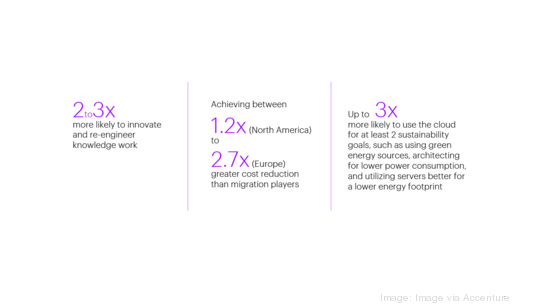
When you’ve consulted with Fortune 500 companies as long as I have, you’re afforded an aerial view of the competitive landscape. When it comes to cloud, that aerial view includes how companies around the world are using cloud to improve their businesses.
The top reason I see is cost savings. And the second is speed and agility. No C-suite executive will turn down a chance to save money while becoming a faster, more agile organization.
Where I usually can add value to their perspective can be summed up in one simple sentence: Cloud is not a gigantic data center--it’s an operating model.
Use cloud to its fullest potential for full value
Going to cloud provides leaders across a company a chance to rethink the way they do things. If they make the most of that blank-slate opportunity, they can not only run today’s processes better—they can create an entirely new set of processes. Designed correctly, those processes will better suit their business needs than traditional methods ever did.
The average organization plans to migrate more than two-thirds of workloads to the cloud. That’s shown by Accenture’s latest cloud research with 4,000 C-suite executives, in both information technology (IT) and non-IT roles, across 25 countries and 16 industries. However, on average, over the next three to five years, only half are using the full potential of cloud to transform their day-to-day business operations, carry out knowledge work and modernize applications to meet business needs. That’s a missed opportunity.
Most organizations today deploy some mix of public, private and edge clouds, with little integration between them. As a result, innovation, data and best practices achieved in one part of the organization aren’t benefitting others. When that happens, companies miss out on value they could have reaped. But, a small percentage of organizations are getting it right, positioning themselves to reap the greatest value from the cloud. How? They view cloud as a continuum of technologies that spans different locations and types of ownership, dynamically supported by cloud-first 5G and software-defined networks. This view means they move beyond “cloud as data center” to instead use cloud strategically to support the ever-changing needs of their business.
One dozen in 100 gets it right
Just 12% to 15% of companies are acting on this perspective—and it shows in their business results:

Siemens, a 174-year-old company, was able to use cloud to help it further its Industry 4.0 vision. It now helps engineering and manufacturing companies use vast amounts of data from their factories, equipment and production processes to operate more efficiently. It knew companies would need digital platforms to facilitate the process, so Siemens chose to proceed with a multi-cloud best-of-breed approach, working with multiple cloud providers to broaden the choice of platforms offered to organizations.
Approach is everything
When executives tell me they tried cloud and “it didn’t work,” I always ask how they approached it. Usually, they have moved workloads to cloud, provisioning things exactly as they had them in their legacy infrastructure. What should have happened instead was that they provisioned exactly what they needed. That’s the beauty of cloud. You can dial it up or down at a moment’s notice as needs change.
I counsel clients to go one better—determine which apps should be modernized, which ones you can toss to the wayside, what you should run those apps on, etc. Take this chance to design from a blank slate instead of bringing over what probably could have been improved anyway.
Making it work in the real world
I’m a realist. While huge transformations are the best route for cloud—you maximize your growth and innovation that way—many are still executed business case by business case. IT and the business side of the house must work together and it gets complex. But having that future vision—Vision with a capital V—of what you want to attain via cloud morphs a simple migration into an impactful transformation. At a certain point down that road, you realize you have consolidated and modernized your infrastructure—and you’re cloud-enabled in the very best way.
This approach means continuously analyzing your cloud needs but the good news is, artificial intelligence (AI) and analytics are getting better every day at doing that for companies. And they’re doing it with an accuracy that beats human accuracy, freeing us to strategize, innovate and all those other things humans do best.
As your company contemplates the possibilities of cloud, I suggest three first steps:
· Create a vision that clearly states the core values and future aspirations.
· Identify competitive vulnerabilities and shortcomings.
· Clearly classify capabilities, with a line of sight from where your organization is today to your future aspirations.
Don’t settle for the status quo
I’ll leave you with one more example. 3M started its cloud journey in 2016. When the COVID-19 pandemic struck, and hospitals were in desperate need of protective gear, 3M’s manufacturing plants found it difficult to gather, transfer and use the data from production systems. It turned to edge computing, enabled by cloud.
The company began pushing data from the plant’s on-premises SQL Server to Azure SQL Edge. This enabled faster and more streamlined processes while also enabling 3M to predict a manufacturing line’s problems in advance. By the end of 2020, the company had doubled its global production of N95 respirators to more than 1.1 billion per year.
Your company’s cloud journey may not be about saving lives. Whatever cloud can enable for your organization, go for it. Don’t settle for “cloud as data center.” It can do so much more.